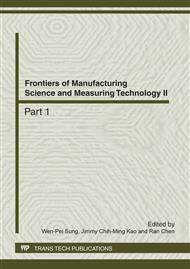p.136
p.140
p.144
p.148
p.152
p.159
p.163
p.167
p.171
Effect of Scanning Methods on Residual Stress Distribution during Direct Laser Metal Deposition Shaping
Abstract:
In order to improve that quality of sample and decrease the stress during process, it is of great importance to study the residual stress distribution during direct laser metal deposition (LMDS) process. In this paper, according to the “element life and death” technique of finite element method ,with APDL, we simulated the effects of long edge reciprocating scanning method, short edge reciprocating scanning method and direction orthogonal changing in different layers reciprocating scanning method to residual stress distribution during whole LMDS process are studied. The residual stress distribution under different scanning methods is researched in detail. Using the same process parameters, the simulation result show good agreement with the features of sample which fabricated by LMDS
Info:
Periodical:
Pages:
152-158
Citation:
Online since:
April 2012
Authors:
Price:
Сopyright:
© 2012 Trans Tech Publications Ltd. All Rights Reserved
Share:
Citation:


